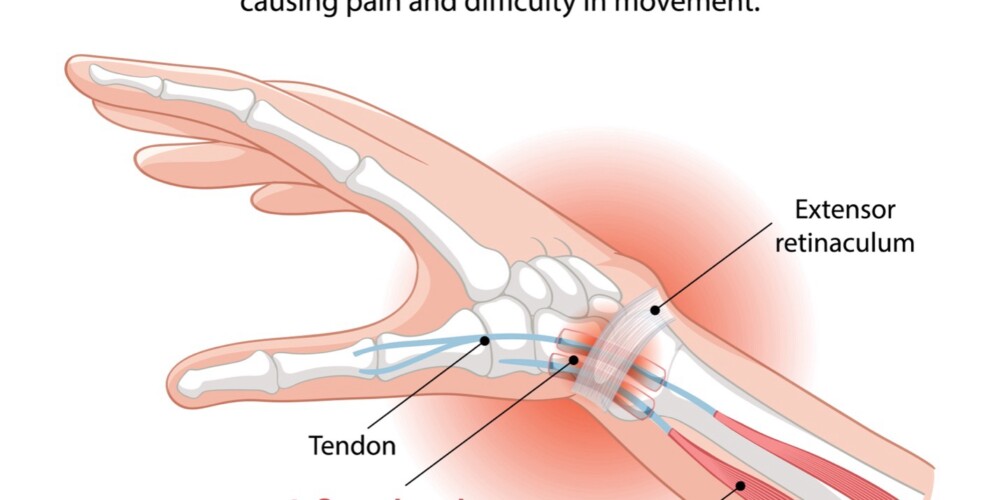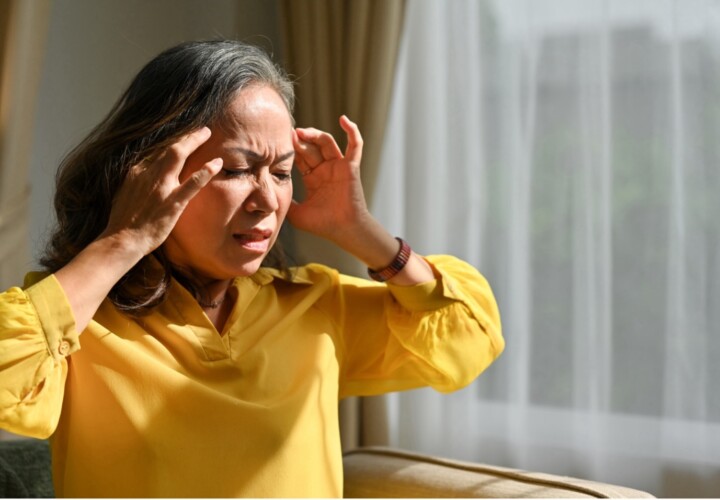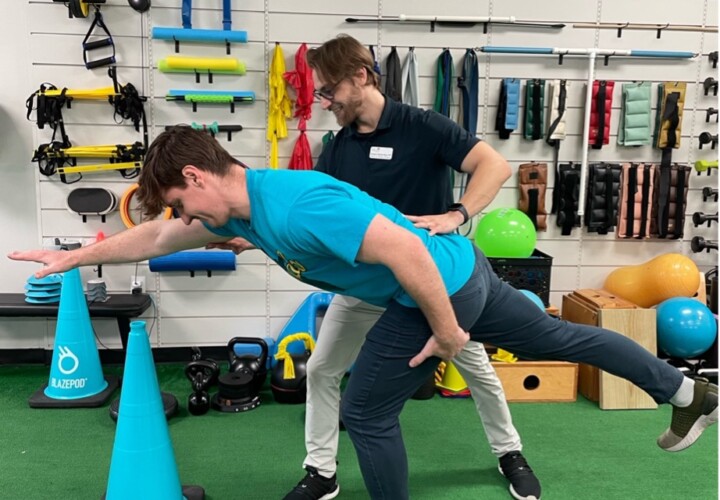Understanding De Quervain’s Tenosynovitis: Causes, Symptoms, and the Role of Physical Therapy in Recovery
De Quervain’s Tenosynovitis is a common yet often misunderstood musculoskeletal condition that affects the tendons located on the thumb side of the wrist. Specifically, this condition involves inflammation of the tendon sheaths that encase the abductor pollicis longus (APL) and the extensor pollicis brevis (EPB) muscles. These two tendons are crucial for the functional movement of the thumb, enabling actions such as thumb abduction (moving the thumb away from the hand) and thumb extension (moving the thumb out and back). The inflammation that occurs within these tendon sheaths can cause significant pain and limit functional use of the hand and wrist, particularly during activities that involve gripping, lifting, or repetitive wrist motions.
Anatomy and Biomechanics of the Thumb and Wrist
To understand De Quervain’s Tenosynovitis more fully, it’s helpful to take a closer look at the anatomy involved. The tendons affected by this condition pass through a fibrous tunnel known as the first dorsal compartment of the wrist. This tunnel is a narrow passageway located near the base of the thumb, formed by connective tissue structures that help guide and stabilize the tendons as they move. Under normal conditions, the APL and EPB tendons glide smoothly through this tunnel, allowing the thumb to move efficiently.
However, when these tendons are subjected to repetitive stress or overuse, the sheath that surrounds them can become inflamed. This inflammation leads to thickening of the sheath or the tendons themselves, resulting in a narrowing of the compartment and restricted movement. In turn, this causes friction, pain, and irritation during thumb and wrist motion. The result is a cycle of inflammation and discomfort that can significantly impair daily function.
Etiology: What Causes De Quervain’s Tenosynovitis?
De Quervain’s Tenosynovitis is most commonly associated with repetitive strain or overuse. Individuals who engage in activities that require frequent, forceful, or sustained thumb and wrist motions are at higher risk of developing this condition. This can include a wide range of people, from new parents lifting their children repeatedly, to office workers who type and use a computer mouse for extended periods, to manual laborers who handle tools or machinery daily.
Certain sports or hobbies—such as gardening, golf, racquet sports, knitting, or playing musical instruments—can also contribute to overuse of the thumb tendons. Even prolonged use of smartphones and handheld devices has been linked to an increase in De Quervain’s symptoms due to the repetitive swiping, scrolling, and gripping actions involved.
In some cases, trauma or direct injury to the wrist may also play a role. Swelling from an acute injury can alter the dynamics within the tendon sheath and increase the likelihood of developing tenosynovitis. Additionally, individuals with underlying inflammatory conditions such as rheumatoid arthritis may be predisposed to tendon sheath inflammation.
Recognizing the Symptoms of De Quervain’s Tenosynovitis
The hallmark symptom of De Quervain’s Tenosynovitis is pain along the radial (thumb) side of the wrist, particularly at the base of the thumb. This pain may present gradually or suddenly and often intensifies with specific movements or tasks. Common complaints include:
- Pain with thumb movement, particularly when extending or abducting the thumb
- Discomfort during gripping, pinching, or lifting objects
- Pain during wrist movements, especially when turning the wrist or lifting items with the palm facing down
- Swelling and tenderness near the base of the thumb
- A catching or snapping sensation when moving the thumb
- Reduced range of motion or functional use of the thumb and hand
In some cases, the pain may radiate up the forearm or down into the thumb and fingers. The discomfort can range from mild irritation to intense pain that interferes with daily activities.
One of the clinical tests commonly used to assess for De Quervain’s Tenosynovitis is the Finkelstein test. During this test, the patient makes a fist with the thumb tucked inside the fingers and then gently ulnarly deviates (bends the wrist toward the pinky side). A sharp pain on the thumb side of the wrist during this motion is considered a positive sign for the condition.
The Role of Physical Therapy in Managing De Quervain’s Tenosynovitis
Physical therapy plays a vital role in both the conservative management and long-term resolution of De Quervain’s Tenosynovitis. Successful rehabilitation depends on addressing the underlying causes of tendon irritation, reducing inflammation, improving functional strength and flexibility, and educating the patient on activity modification to prevent recurrence.
Treatment begins with a thorough assessment by a licensed physical therapist, who will evaluate the patient’s symptoms, functional limitations, daily activities, and contributing risk factors. An individualized treatment plan is then developed to meet the patient’s unique needs and goals.
- Reducing Inflammation and Controlling Symptoms
The initial phase of treatment focuses on decreasing inflammation and alleviating pain. This is typically achieved through a combination of rest, activity modification, and inflammation management techniques. Patients are often advised to avoid aggravating movements and limit repetitive thumb and wrist activities during this time. A thumb spica splint may be recommended to immobilize the thumb and wrist, allowing the inflamed tendon sheaths to heal.
Other effective strategies for reducing inflammation include:
- Cold therapy: Applying ice packs to the affected area for 10–15 minutes several times per day helps reduce swelling and numb pain.
- Anti-inflammatory modalities: Physical therapists may use therapeutic ultrasound, iontophoresis, or low-level laser therapy to target inflammation at the tissue level.
- Manual therapy: Gentle soft tissue mobilization techniques may help reduce tension in surrounding muscles and improve circulation to the area.
Patient education during this phase is critical. Understanding the importance of rest and avoiding pain-provoking activities is key to preventing the condition from worsening. Patients are also counseled on proper ergonomics, posture, and body mechanics to minimize stress on the affected tendons.
- Restoring Mobility and Strength
Once the acute inflammation subsides, the focus of treatment shifts toward restoring mobility and rebuilding functional strength. De Quervain’s Tenosynovitis often results in stiffness or weakness in the wrist and thumb due to pain-avoidance behaviors. Carefully guided exercises are introduced to restore the normal glide of the tendons and improve coordination of the hand and wrist.
Stretching exercises for the thumb and wrist are incorporated to maintain and improve flexibility. Examples may include:
- Thumb abduction and extension stretches to gently lengthen the APL and EPB tendons
- Wrist range-of-motion drills in flexion, extension, and radial/ulnar deviation
- Nerve glides if neural irritation is contributing to symptoms
Strengthening exercises focus on gradually loading the involved tendons without provoking inflammation. Resistance bands, therapy putty, or small hand weights may be used to strengthen:
- Thumb extensors and abductors
- Wrist extensors and flexors
- Forearm and intrinsic hand muscles
Your physical therapist will progress exercises in a controlled manner, ensuring that movement patterns are functional and pain-free. The ultimate goal is to restore the patient’s ability to grip, lift, write, carry, and perform all essential activities without discomfort.
- Functional Training and Return to Activity
As strength and mobility improve, rehabilitation progresses toward functional training. This phase of therapy is essential for individuals whose work or hobbies contributed to the development of De Quervain’s Tenosynovitis. Your therapist will simulate real-life tasks and train you on safer ways to perform them.
Workplace ergonomics and proper lifting techniques are emphasized to minimize stress on the tendons. For athletes or musicians, sport- or instrument-specific training may be incorporated to ensure a safe return to performance. For new parents, therapists can provide strategies for safely lifting and carrying children to avoid reinjury.
Additionally, your therapist will help you develop a long-term maintenance plan that includes stretching, strengthening, and rest strategies tailored to your lifestyle. Understanding how to pace activities, take breaks, and listen to your body’s warning signs is crucial for avoiding flare-ups.
When to Seek Physical Therapy
If you are experiencing persistent pain at the base of the thumb or wrist, difficulty with gripping or lifting, or notice swelling or restricted movement, it may be time to consult a physical therapist. Early intervention is key in managing De Quervain’s Tenosynovitis effectively. When left untreated, the condition may become chronic and lead to lasting pain or compensatory movement patterns that affect the shoulder, elbow, or neck.
Physical therapy offers a conservative, evidence-based approach to healing that addresses both the symptoms and root causes of the condition. In most cases, patients experience significant relief and restored function without the need for medications or surgery.
However, in rare cases where conservative treatment is unsuccessful, further medical evaluation may be needed. A physician may recommend corticosteroid injections or, in chronic or severe cases, surgical intervention to release the tendon sheath. Even in these cases, physical therapy remains essential both before and after medical procedures to ensure optimal outcomes.
Taking Control of Your Recovery
De Quervain’s Tenosynovitis, while frustrating and painful, is a highly treatable condition when managed appropriately. With the support and guidance of a qualified physical therapist, you can reduce inflammation, restore mobility and strength, and return to your normal activities with confidence.
The key to effective treatment lies in an individualized approach that targets your specific symptoms, lifestyle, and goals. At the heart of this process is patient education—understanding how your condition developed, what factors are contributing to it, and how to prevent it from recurring in the future.
If you suspect you may be dealing with De Quervain’s Tenosynovitis, don’t wait for the pain to worsen. Seek the expertise of a licensed physical therapist who can guide you through a customized recovery plan and empower you with the tools needed to protect your hand and wrist health for years to come.
Ready to Get Relief from De Quervain’s Tenosynovitis? We’re Here to Help!
At Hohman Rehab and Sports Therapy, our expert physical therapists are ready to develop a personalized treatment plan tailored to your needs and goals. Whether your symptoms just started or have been interfering with your daily life for a while, we’re here to support your recovery and help you get back to doing what you love—pain-free.
We proudly serve Central Florida with three convenient locations:
📍 Clermont Office
236 Mohawk Road, Clermont, FL 34715
📞 Phone: 352-404-6908
📠 Fax: 352-404-6909
📍 Ocoee Office
11095 W. Colonial Drive, Ocoee, FL 34761
📞 Phone: 407-347-8936
📠 Fax: 352-404-6909
📍 Apopka Office
125 S. Park Avenue, Apopka, FL 32703
📞 Phone: 407-410-3200
📠 Fax: 352-404-6909
Scheduling your evaluation is easy!
Visit our website at www.hohmanrehab.com to schedule an appointment.
If you’re experiencing pain, swelling, or limited thumb movement, don’t wait—early treatment leads to better outcomes. Let our compassionate and knowledgeable team help you regain your strength, reduce your pain, and restore your quality of life.
We look forward to helping you feel better—faster!




